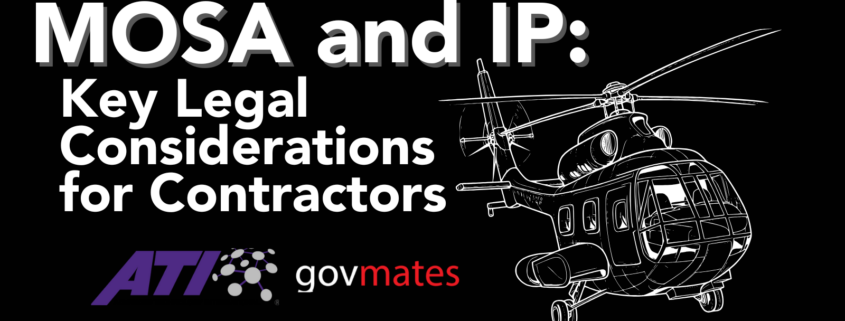MOSA and IP: Key Legal Considerations for Contractors
The Modular Open Systems Approach (MOSA) framework represents a shift from traditional procurement processes, particularly in how intellectual property (IP) and data rights are handled. MOSA allows for greater flexibility in design and procurement, emphasizing modularity, open architecture, and adaptability while still considering the protection of proprietary technologies.
Data Rights and Intellectual Property:
- Contractors must carefully consider how to protect their intellectual property (IP) when entering into MOSA-related contracts. For both hardware and software offerings, it’s crucial to balance the open architecture requirements of MOSA with the need to safeguard proprietary code and design.
- Contractors can negotiate data rights to retain control over certain parts of their IP, particularly when dealing with critical technologies. This may involve ensuring that government agencies have access to necessary data and software interfaces without giving up the core intellectual property.
Negotiation Strategy:
- Focus on Key Interests: Organizations should identify which aspects of the contract—such as data rights, ownership, or specific technical innovations—are most critical to their business strategy and future competitiveness.
- Negotiate Early: It is important to engage in negotiations as early as possible in the procurement process to set the terms in favor of protecting valuable technologies.
- Push Back on Terms: Companies can push back on contract clauses that may negatively impact their competitive edge or critical technologies. This can involve negotiating more favorable data rights or IP clauses.
Challenges of MOSA:
- One of the challenges in MOSA-related agreements is the impact of changes made to the contract later in the negotiation process. These changes may affect the underlying design and architecture of the product, resulting in a derivative effect and the need to change other parts of the structure. It’s essential that contractors address critical points early in the process to prevent delays and redesigns.
MOSA Applies to Software, too:
- MOSA requires that contractors meet certain open architecture standards, especially when dealing with software. While this fosters flexibility and collaboration with the government and other contractors, it also means that companies need to define the boundaries of their IP and how it will be used within the open system.
- Contractors should ensure that any shared software modules or interfaces are properly protected, while also ensuring compliance with MOSA’s open architecture guidelines.
MOSA Preparedness:
- Data Rights Management: As a prime contractor, ensuring the negotiation of proper data rights with subcontractors is critical. This includes clarifying the use of data and ensuring that no rights to key technologies are lost during the modularization process.
- Balance Openness with Protection: The key to successful MOSA implementation is balancing openness for system integration with the protection of proprietary technologies. Contractors should be vigilant in ensuring that the architecture remains flexible for future upgrades and integrations, while safeguarding their core technology.
Collaboration Between Contractors and the Government:
- Effective communication and collaboration are key to creating a fair balance between openness and protecting proprietary technologies. Contractors and the government need to work together to develop clear and mutually beneficial terms that allow for flexibility without compromising on security or competitive advantage.
In conclusion, navigating the legal complexities of MOSA requires a proactive approach to negotiation, an understanding of data rights and IP implications, and strategic management of design changes during development. By negotiating the right terms upfront, contractors can ensure they maintain control over critical technologies and are well-positioned to meet the demands of modular and open system architectures.




